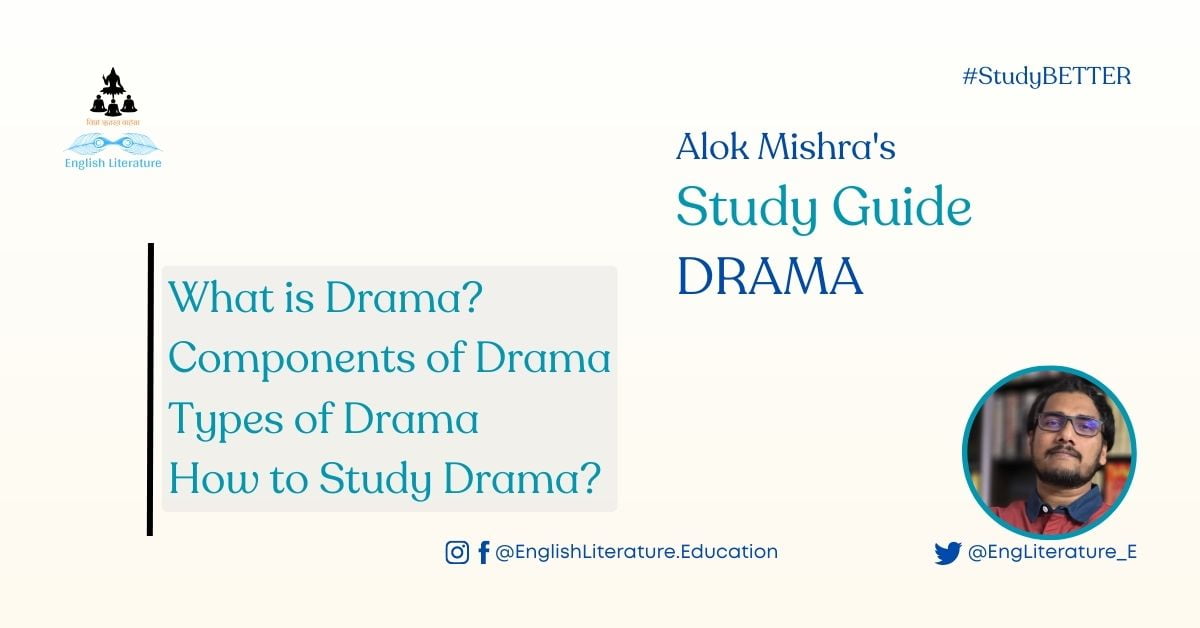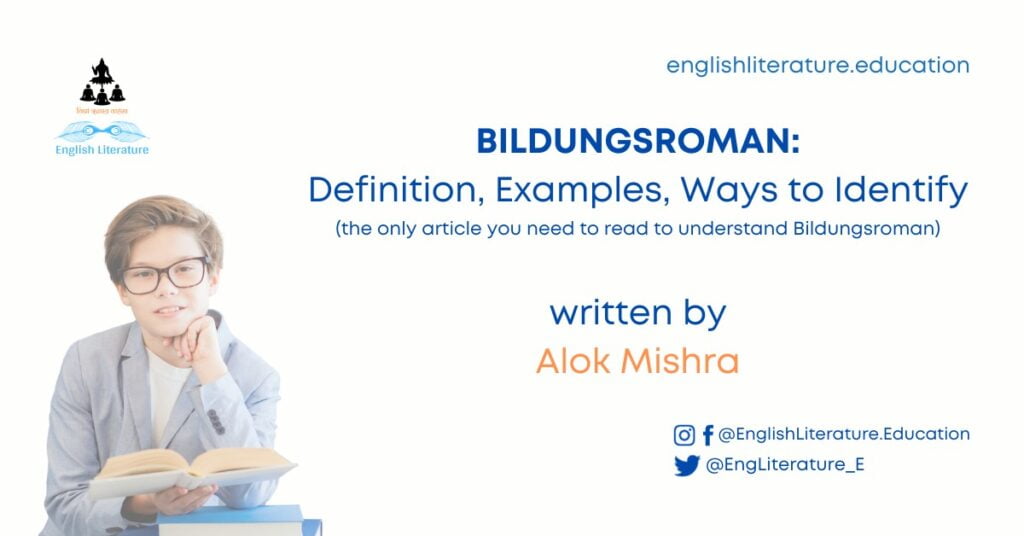Life is a drama… written by God (some say) and realised by us (we all know). However, when it comes to understanding drama as a concept – in literary terms or otherwise – it is a drama of mess and absurdity, at times, if you are new to the world of drama as a subject matter of study. Otherwise, we all may love to watch a nice drama being enacted by our favourite stage actors. Who would not?
Now, coming to the point, I have tried to Drama as a literary concept as simple as possible. As a genre and an artistic expression, and also from the point of view of the audience, there are many things about Drama one must know as a student of literature. In this article, you will learn what is Drama. Also, with its definition, you will know different types of drama, vital components of drama and a few other essential features of it. So, without any delay, let’s get straight into the subject at hand. Let us begin right with the definition of drama.
What is Drama?
Drama, both as a standalone concept and within the realm of literature, holds significant importance as artistic expression. It is a genre that presents a narrative through the enactment of characters on a stage, often involving dialogue, actions, and conflicts that unfold in front of an audience. In the domain of literature, drama often refers to written works intended for performance, encompassing plays and theatrical scripts that are designed to be enacted by actors on a stage.
It is remarkable to note that in literature, drama differs from other forms of storytelling in its focus on dialogue and the interaction between characters to convey the narrative, themes, and emotions. The structure of a dramatic work typically includes acts and scenes, which guide the progression of the storyline and offer distinct moments of tension, climax, and resolution. Through dialogue and actions, characters reveal their motivations, conflicts, and growth, making drama a dynamic medium for exploring the human experience.
Great dramatic works (or plays) in literature often reflect the societal, cultural, and psychological aspects of the time in which they were written. Playwrights utilise their creations to delve into complex themes, highlight moral dilemmas, challenge social norms, and provoke thought and emotional engagement among their audiences. The power of drama lies not only in its ability to entertain but also in its capacity to engage with issues that resonate deeply with the human condition.
Hint for Literature Students: before you start studying drama:
Students of English literature (or literature in any other language) should mark that understanding the nuances of drama in literature is crucial for analysing plays. They must take efforts to make themselves dexterous in identifying literary devices such as dramatic irony, soliloquies, and monologues, and uncovering the layers of meaning beneath the surface of characters’ interactions. By delving into the structure, themes, and character development of dramatic works, they can have a richer understanding of the complexities and artistry within this genre.
What are the Components of a Drama?
Below, you will find a list of components of a drama. I have tried to keep the sequence open, as open as I could, and it does not necessarily mean any order. You can understand the importance of each component and use your intellect to identify which ones are indispensable and which ones may be left alone when the need arises.
1. Characters:
Characters are the heart of any dramatic work. They drive the plot, convey themes, and engage the audience emotionally. Characters can be protagonists, antagonists, foils, or supporting roles. Each character has distinct traits, motivations, and relationships that shape their interactions and influence the story’s development.
Example: In William Shakespeare’s tragedy “Hamlet,” the titular character Hamlet, driven by his quest for revenge and internal conflicts, interacts with other characters like Ophelia, Polonius, and Claudius, each contributing to the unfolding drama.
2. Plot:
The plot is the sequence of events that constitute the storyline. It includes the introduction, rising action, climax, falling action, and resolution. The plot structure creates tension and intrigue, guiding the audience through the narrative journey.
Example: The plot of Arthur Miller’s play “The Crucible” follows the escalation of accusations and trials during the Salem witch trials, building tension until the climactic courtroom scene.
3. Conflict:
Conflict is the driving force behind the drama. It can be internal (within a character’s mind) or external (between characters or circumstances). Conflict propels the story forward and illuminates the characters’ struggles and growth. Conflict makes a drama engaging, reflective and consuming. A drama without conflict may seldom exist.
Example: In Sophocles’ tragedy “Oedipus Rex,” the protagonist’s quest to uncover the truth about his past and his role in his father’s murder leads to a profound internal conflict as well as clashes with other characters.
4. Dialogue:
Dialogue is the spoken communication between characters. It reveals their personalities, intentions, emotions, and relationships. Effective dialogue captures the essence of the characters and advances the plot.
Example: The witty and engaging dialogue between Beatrice and Benedick in Shakespeare’s comedy “Much Ado About Nothing” not only entertains but also showcases their evolving romantic relationship.
5. Setting:
The setting establishes the time, place, and environment in which the drama unfolds. It influences the mood, atmosphere, and context of the story.
Example: Tennessee Williams’ “A Streetcar Named Desire” is set in the bustling city of New Orleans, with its distinct ambience and cultural backdrop contributing to the characters’ experiences.
6. Theme:
Themes are the underlying ideas or messages conveyed through the drama. They address universal truths, societal issues, and philosophical concepts. Themes enrich the narrative and provoke thought.
Example: In Henrik Ibsen’s “A Doll’s House,” the theme of women’s societal roles and the pursuit of self-identity is explored through the character of Nora Helmer.
7. Stage Directions:
Stage directions provide guidance for actors, directors, and designers. They describe actions, gestures, emotions, and technical elements that enhance the performance and visualization of the drama.
Example: In Samuel Beckett’s “Waiting for Godot,” the sparse stage directions contribute to the existential atmosphere and emphasize the characters’ sense of aimlessness.
8. Symbolism:
Symbolism involves the use of objects, actions, or characters to represent abstract ideas or concepts. Symbolic elements add depth and layers of meaning to the drama.
Example: In Lorraine Hansberry’s “A Raisin in the Sun,” the plant that Mama nurtures symbolizes her dreams of a better future for her family.
What are the types of Drama?
There are several major types of drama, each with its own distinctive characteristics and purposes. Here is a list of some of the major types, along with examples and detailed descriptions:
1. Tragedy:
Tragedy is a genre that explores the downfall of a protagonist due to tragic flaws, external circumstances, or a combination of both. Tragedies evoke emotions such as pity and fear and often end in catastrophe or death for the central character.
Example: William Shakespeare’s “Macbeth” follows the tragic journey of Macbeth’s ambition leading to his ultimate downfall and demise.
2. Comedy:
Comedy is characterised by humour, wit, and lightheartedness. It often involves misunderstandings, mistaken identities, and humorous situations. Comedies aim to entertain and uplift the audience.
Example: Oscar Wilde’s “The Importance of Being Earnest” is a classic comedy that employs wit and satire to explore themes of social conventions and identity.
3. Tragicomedy (Dramedy):
Tragicomedy combines elements of tragedy and comedy, often blending serious themes with humorous moments. These plays explore the complexities of life, encompassing both light and dark aspects.
Example: Tom Stoppard’s “Rosencrantz and Guildenstern Are Dead” reimagines the story of “Hamlet” from the perspective of two minor characters, balancing existential reflections with comedic exchanges.
4. Historical Drama:
Historical dramas are set in a specific historical period and often involve real historical figures and events. They provide insight into the past while addressing universal themes.
Example: Friedrich Schiller’s “Mary Stuart” dramatizes the conflict between Mary, Queen of Scots, and Queen Elizabeth I, exploring power dynamics and personal struggles.
5. Musical Drama:
Musical dramas combine theatrical performance with music, including songs and often dance routines. They can cover a wide range of themes and emotions, utilizing music to enhance storytelling.
Example: “Les Misérables” by Claude-Michel Schönberg and Alain Boublil adapts Victor Hugo’s novel into a musical drama that portrays the struggles of various characters against the backdrop of 19th-century France.
6. Absurdist Drama:
Absurdist dramas challenge traditional narrative structures and explore the absurdity of human existence. They often feature illogical situations, disjointed dialogue, and existential themes.
Example: Samuel Beckett’s “Waiting for Godot” is a quintessential absurdist play where two characters engage in nonsensical conversations while waiting for someone named Godot.
7. Political Drama:
Political dramas centre around political conflicts, ideologies, and power struggles. They can focus on individuals, groups, or entire societies dealing with political issues.
Example: George Orwell’s “Animal Farm” uses allegory to portray the rise of totalitarianism and the corruption of political ideals through the actions of farm animals.
8. Melodrama:
Melodramas emphasize heightened emotions and moral contrasts. They often feature clearly defined heroes and villains, and their plots revolve around intense emotional situations.
Example: Henrik Ibsen’s “Ghosts” is a melodrama that tackles taboo subjects like venereal disease and societal expectations within a family.
How to Study a Drama the Best Way?
Studying a drama effectively requires a systematic approach that delves into its various components and layers. Here’s a step-by-step guide to help you navigate the process:
1. Preliminary Reading:
Begin by reading the drama thoroughly. Read it once to grasp the overall plot and storyline. Take note of initial impressions, emotions, and questions that arise as you read.
2. Contextual Research:
Research the playwright’s background, the historical period, and cultural influences at the time the drama was written. Understanding the context enhances your interpretation of the work.
3. Character Analysis:
Analyse the characters’ personalities, motivations, and relationships. Take note of how they evolve throughout the drama. Pay attention to their roles in advancing the plot and conveying themes.
4. Plot Structure:
Break down the drama’s plot into acts and scenes. Identify the introduction, rising action, climax, falling action, and resolution. Map out the progression of conflicts and events.
5. Theme Exploration:
Identify the central themes and underlying messages of the drama. Consider how characters, dialogue, and events contribute to the exploration of these themes.
6. Dialogue Examination:
Analyse the dialogue between characters. Identify key speeches, monologues, and dialogues that reveal character traits, emotions, and thematic elements. Look for literary devices such as metaphors, similes, and symbolism.
7. Stage Directions and Setting:
Study the stage directions and setting descriptions. Visualise how the playwright intended the scenes to be staged and how the environment contributes to the mood and themes.
8. Conflict Identification:
Identify the primary conflicts within the drama. Distinguish between internal conflicts (within characters) and external conflicts (between characters or external forces).
9. Symbolism and Imagery:
Identify symbolic elements and recurring imagery throughout the drama. Consider how these symbols enhance the meaning and depth of the story.
10. Comparative Analysis:
Compare the drama with other works by the same playwright or within the same genre. Identify similarities and differences in themes, characters, and techniques.
11. Cultural and Societal Analysis:
Consider how the drama reflects the cultural and societal values of its time. Explore how it addresses relevant issues and challenges norms.
12. Critical Interpretation:
Read critical analyses, reviews, and scholarly articles about the drama. Engaging with different perspectives can enrich your understanding and help you form your own interpretation.
13. Personal Response:
Reflect on your emotional and intellectual responses to the drama. What aspects resonated with you? How did the drama affect your thoughts and emotions?
14. Discussion and Interaction:
Engage in discussions with peers, classmates, or online communities. Sharing insights and perspectives can lead to deeper understanding.
15. Writing and Presentation:
Summarise your analysis in a well-structured essay, presentation, or discussion. Support your points with evidence from the text and external research.
16. Revisiting and Reflecting:
After completing your analysis, revisit the drama with fresh insights. Reflect on how your understanding has evolved and consider new interpretations.
By following this comprehensive guide, you’ll be able to delve deeply into the layers of the drama, uncovering its nuances and appreciating the artistry and messages woven into the narrative. This methodical approach will enable you to attempt a comprehensive and insightful analysis of the drama you’re studying.
Conclusion:
So, in this article, we have understood the definition of Drama, the major types of Drama with examples and also the chief components that form a good drama. Moreover, we also tried to form a list of actions or activities that we can execute to study and understand a play better and comprehensively. I am sure if you go through this study guide carefully, you will have a better approach to studying drama. All the best! Do well and keep learning!
By Alok Mishra
for the English Literature Education Platform





20 Comments. Leave new
Sir please next time talk more on drama and give many types of drama
Interesting topic
oh thats too much informative now i will be ready my annual exam preparation who held on 20 may so thank you sir its amazing and worthful topic…………………
litteraly so long this is for my school assignment and its so annoying. but than you for putting your time on this and helping me understand
Thanks so much sir, more wisdom, knowledge and understanding.
once again thanks 🙏
Always had problem with understanding the features of drama,so this was very helpful and it really cleared my misunderstanding.Thank you very much
It helped a lot
Thank guys. I what appreciate you. Keep up the good work. God bless you guys.
It helps me a lot
Its very very very helpful. Thank you for taking time to write and post.
What are the feature of drama
Thanks for all the information and details it’s useful and clear
WOW
Thank you very much. I have learnt a lot from this
This is a very helpful article. I am a BA first semester student. Totally confused where to begin. This one helped me understand many things about drama. I also explored other articles on the site helpful for beginners in English literature. Please keep posting more. Thanks so much
Very good article. It really helped me understand the features of drama. Thank you
Great article I give most benefits
This is easier way for learning, reading, understanding
Very helpful with thanks.
Sir, You should also bring an article on Indian classical literature.
Above article is fantastic about drama.
Thanks for reading, and this comment, Sanjana!
I will write that article soon. I intend to keep writing articles about whatever I have to teach first-semester students of the new CBCS course, with an English major.
Keep exploring! All the best!